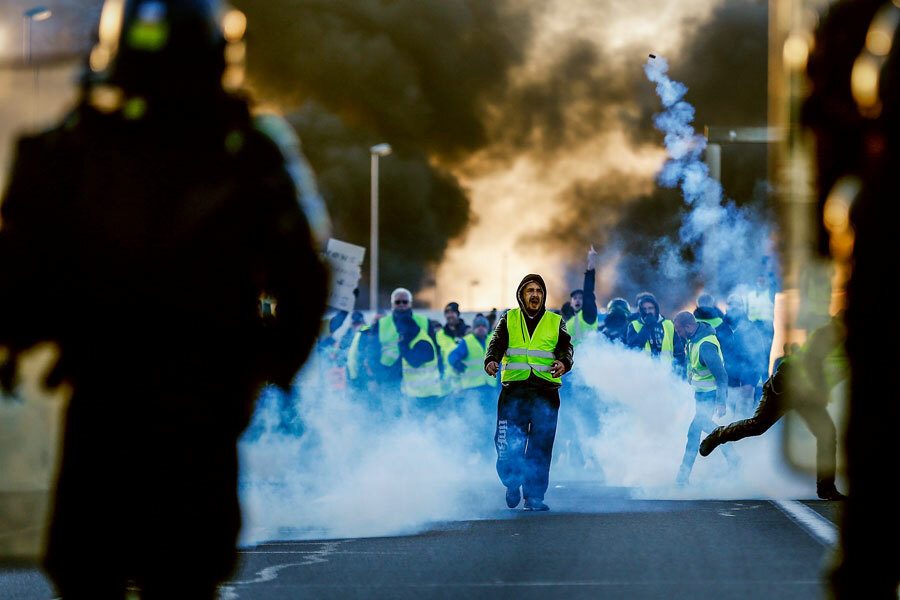What the Yellow Vests Have in Common with Occupy
Inside the mass protests that are rocking France.
Cole Stangler

PARIS — In Belleville Park, a small, steep public garden with panoramic views of the city, about 40 supporters of the gilets jaunes (Yellow Vest) movement have gathered on a chilly January night for what’s billed as a “neighborhood popular assembly.” It’s the third such meet-up to discuss what residents of this historically working-class quarter can do to support the wave of demonstrations.
It’s a wide-open question, much like the future of the Yellow Vest revolt. Online anger over a planned doubling of the fuel tax, to about 25 cents a gallon, spilled into the streets in November 2018. The movement took its symbol from the clothing item required of French motorists since 2008. Rooted in rural areas and outer suburbs, the demonstrations quickly spread, thanks in no small part to social media. They soon came to represent deeper frustrations with the rising cost of living. Far from anti-environmental, the movement simply called on the wealthy to pick up the tab for France’s transition away from fossil fuels.
After weeks of traffic blockades, disruptive marches and occasionally violent clashes with the police, in December 2018 the Yellow Vests won a series of concessions from President Emmanuel Macron: the cancellation of the fuel tax increase, the scrapping of a separate tax hike on pensions passed the previous year, and the expansion of a state subsidy for low-wage workers that could amount to a monthly pay bump of roughly $115. Nevertheless, the protests persist.
“I want to keep pissing off the politicians,” Jean Robert, a 71-year-old retiree, tells the group assembled in Belleville Park. “Whatever we can do to keep putting pressure on them.”
The Yellow Vest movement is remarkably grassroots, organized independently of political parties and unions, and varying substantially by location. Protesters’ calls to tax the rich and to raise wages have earned support from the French Left.
But the Yellow Vests have also won sympathy from the country’s far right. The ever-calculating Marine Le Pen of the newly renamed National Rally party (formerly the National Front) has paid it lip service, and a small share of demonstrators appear to share her warped diagnosis of French society’s ills — calling, for instance, on France to exit the United Nations’ Global Compact for Migration, which they see as a Trojan horse for mass immigration from Africa and the Middle East.
All that seems far removed from this meeting, though, whose participants are a snapshot of Belleville itself, long inhabited by immigrants and their descendants, especially from North Africa. Attendees are young and old, white and brown, leading a freewheeling two-hour discussion reminiscent of the Occupy movement. It’s both exciting and messy: Someone suggests blocking a major food and produce market; another says the movement should focus on economic issues; someone else says residents should focus on housing speculation and spray graffiti on the offices of real estate agencies. Another speaker tells everyone how much fun he had demonstrating in the city’s wealthy neighborhoods.
Yann Le Bihan, a 48-year-old school administrator, takes the floor and mentions a modest decline in public support. While a YouGov study from late November 2018 found 70 percent of the country backed the Yellow Vests, a more recent version of the poll showed 62 percent approval.
“The most important thing you can do is talk to your friends and acquaintances when you hear misinformation about the Yellow Vests,” says Le Bihan. “But we also need to work ourselves on our communication, on our talking points.”
Not everyone agrees. “This is much bigger than talking points or public relations,” Amparo, a 62-year-old schoolteacher who declines to give her last name, says to applause. “We’re in the fight of our lives! … Opinion polls go up and down, the stock market goes up and down, but so what? We’re fighting for our lives.”
Revolutionary ambitions notwithstanding, several pressing issues loom over the movement today. First, there’s the question of the Citizens’ Referendum Initiative, known as the RIC. The most prominent version of the proposal would allow French citizens to introduce and authorize legislation, to nullify laws, to revoke legislators and to amend the constitution — all by referendum. Some Yellow Vests consider it the movement’s single most important demand, though others seem more suspicious. “It’s a super-revolutionary proposal,” bellowed one enthusiastic activist at the Belleville meeting — though he was the only one to mention it.
Then, there is the so-called great national debate. Instead of taking up the RIC, the French government has responded to the protests with a series of discussions — online and in person — designed to address what it views as the country’s deepseated political malaise. They focus on four key themes: taxes and public spending, public services, the fossil-fuel transition and “democracy and citizenship,” which includes immigration. Most Yellow Vests view the entire endeavor as a sham, a desperate effort from authorities to redirect popular frustrations into an institutionalized dead end. Ultimately, the movement’s future could hinge on its capacity to set forth a coherent alternative.
For its part, the group in Belleville has committed to more immediate plans. By the end of the meeting, they’ve set a gathering point for the weekend’s protest in Paris. And they’ve vowed to find a better location to keep holding their “popular assemblies” over the winter — preferably indoors.









